After your arrival at the international airport, you will proceed to Windhoek, the capital city of Namibia. You will find your accomodation in a quiet neighborhood, close to the city centre, with its afro / european flair and a peaceful atmosphere. In the evening you will enjoy the typical Namibia cuisine in one of the several restaurants in the city.
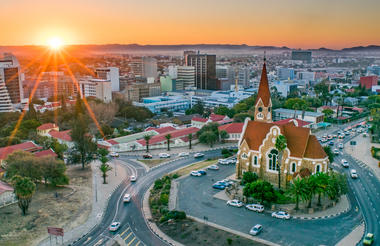
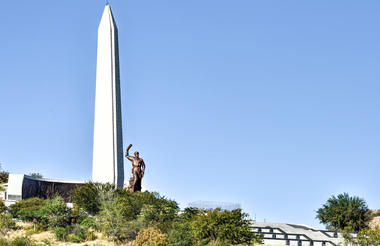
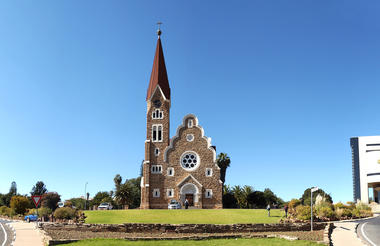
Today your destination will be the southern part of Namibia, the Kalahari Desert. Stretching around 360,000 square miles across Botswana, Namibia and South Africa, the Kalahari Desert is not a desert in the strictest sense of the word because it receives too much rainfall - between 5 and 10 inches annually. Its vast expanses of sand where precipitations filter rapidly leave nothing on the surface afterwards. This peculiarity entitled it to the name of "thirstland" as the first European settlers described Kalahari. This desert is part of the 970,000-square-mile Kalahari Basin, which includes the Okavango River Delta and other wetter areas. The basin encompasses virtually the whole Botswana and more than half of Namibia. The Kalahari sand dunes, some of which stretch west to the Namib Desert, compose the largest continuous expanse of sand on earth. Although the Sahara Desert is larger overall, its sand dunes make up only about 15% of its area. Upon arrival, you will go for a game drive and later on you will enjoy the traditional sundowner on a red Kalahari sand dune, a perfect way to watch the sun sink away into the distant dunes.



After breakfast you will drive by straw-yellow grass plains and red dunes, and visit the picturesque Quiver Tree Forest, located about nine miles (14 km) north of the town of Keetmanshoop. With forked branches and a stout trunk, the quiver tree grows about 30 feet (9 meters) tall. Also called ‘kokerboom’, the quiver tree is an aloe plant, whose pliable bark was used by tribesmen to make arrow quivers. You will stop for lunch in Keetmanshoop and head south for about an hour to enjoy a brief stop at the lovely Naute Dam, a gathering spot for many water birds. Then you will continue towards the Fish River Canyon. The Fish River Canyon is the second largest canyon in the world. It is set in a harsh stony plain dotted with drought resistant succulents and inhabited by a diversity of desert-adapted animals such as the Hartmann’s mountain zebra, springbok and oryx. Its dimensions are enormous: 160 km long, up to 27 km wide and 500 m deep. What is also very impressive is the period of time during which it was formed: 350 million years ago a 20 km wide fault appeared and the river meandered through it in wide loops. When the ancient continent of Gondwana disintegrated 120 million years ago, the Fish River started to dig deep into the ground and create its system of gorges.



You will spend your day exploring the most important geological phenomenon in Namibia: the Fish River Canyon together with the thermal waters area of Ai-Ais Hot Springs and Huns Mountains.



Today your journey will take you to Luderitz. Luderitz is perched on a gaunt rocky outcrop. Devoid of natural vegetation, but bejewelled with late 19th century architecture, Luderitz is not only famous for being the landing spot of the first German settlers in 1883; it is here where the country’s rather poor existence was boosted into glamour, power and success with the discovery of the first diamonds in 1908 at “Kolmanskuppe”. A wide variety of activities and natural heritage sites are found in and around the town, many of which are unknown, or have hardly been experienced by the discerning and adventure seeking guest. You will then take a Bogenfels and Pomona Tour. This a simple trip into the Sperrgebiet (forbidden diamond area) with visits to the abandonded mining town of Pomona and the rock arch at Bogenfels.


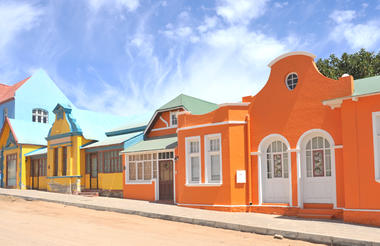
More exciting activities lie ahead. Today you will visit the Kolmanskop Ghost Town. Once a cosmopolitan centre of immeasurable wealth (brought about by the discovery of huge diamond fields in 1908), Kolmanskop stands 5km outside Lüderitz as a haunting monument exposed to the relentless forces of the Namib Desert. The once opulent buildings surrendered slowly to the encroaching desert sands and nowadays they offer an eerie experience when visiting the town on a guided tour. To finish off your day in Luderitz take part in several cruises around Luderitz harbour, options include sunset cruises and a visit to an oyster farm.
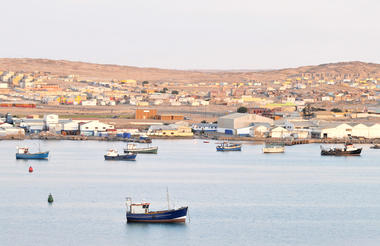
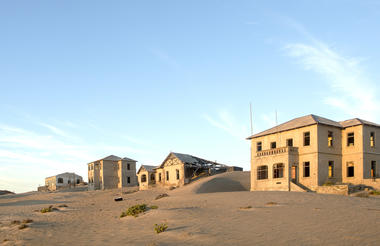
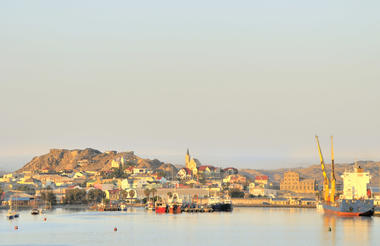
After breakfast you will travel north through the pre-Namib until the Namib Desert. This is the gateway to the Sesriem Canyon and Sossusvlei, where some of the highest sand dunes on Earth stand towering over the white desert plains. The afternoon can be spent relaxing at the pool. The Namib Desert is often referred to as the world's oldest desert. Namibia gets its name from the Namib so it should come as no surprise to discover that the entire western section of the country is part of the Namib. Of course the Namib spreads beyond the borders of Namibia and sprawls into southern Angola and the northern Cape Province of South Africa. A section of the central Namib Desert incorporates The Namib Naukluft Park, one of the largest national parks in Africa, as well as the Naukluft Mountains. The park is a combination of the Namib Desert Park and the Naukluft Mountain Zebra Park as well as sections of the Diamond Area. This whole area is just less than 50,000km2 and its main attractions are Sossusvlei, Sandwich Harbour and the Naukluft hiking and four wheel drive trails. Sossusvlei is the one attraction that should not be missed while you are in Namibia; the dunes are amazing and even though this is a popular tourist destination it is still easy to gain a sense of solitude while climbing one of the dunes or walking to the deadvlei.
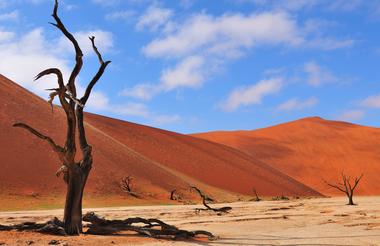
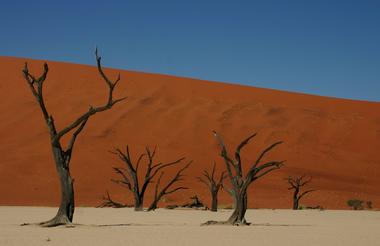
Today you are going on a guided Sossusvlei excursion. At dawn you will enjoy a sunrise excursion to the highest dunes in the world. The variety of its colours and shapes are fantastic.
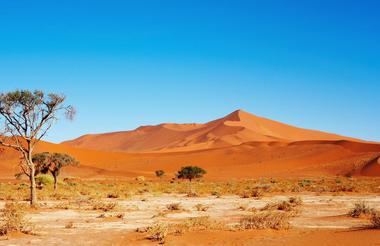
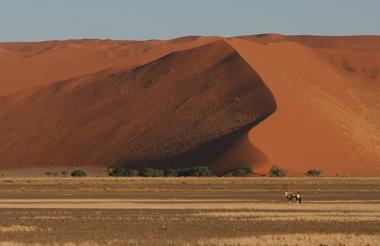
Early departure via Solitaire and the Ghaub and Kuiseb passes to reach Swakopmund, Namibia’s premier holiday resort, that is characterised by a wealth of well-preserved German colonial buildings. Streets names serve as reminders of formers colonial rulers and administrators, while German is still widely spoken. Well-known historic buildings include Woermann House, the old State Railway Station, Alte Kaserne (Old Fort) and the old Magistrate’s Court which now serves as State House in Swakopmund. You have will the rest of the day to yourself to relaxe.
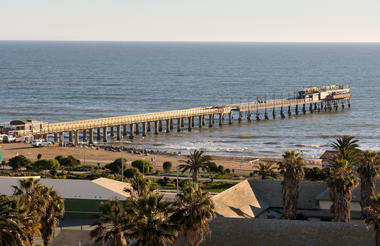
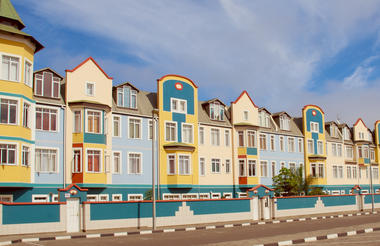
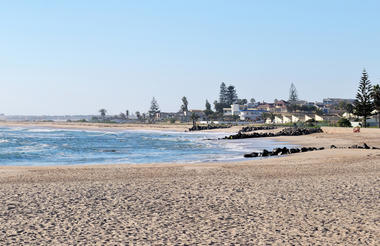
You will spend the day at your leisure in Swakopmund and enjoy the relaxed atmosphere of this coastal town, nestling between the desert and the Atlantic ocean. The promenades, palm trees and beautiful gardens remind of a European seaside resort. Magnificent buildings dating back to the turn of the century give the city its charm. Excursions like boat cruises from Walvis Bay, quad-biking in the nearby dunes or scenic flights can be booked in town. The Marine Aquarium, the interesting Swakopmund Museum, the open wood market and the Kristal Galerie are worth a visit. The Kristal Galerie houses the largest known crystal cluster in the world.
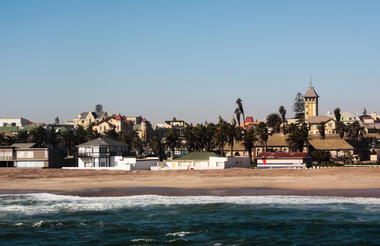
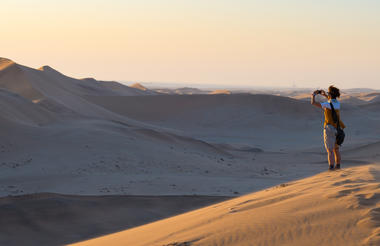
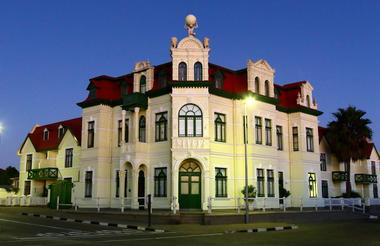
Today you will reach the famous Damaraland. Damaraland is one of the most scenic areas in Namibia, a huge, untamed, ruggedly beautiful region that offers a more adventurous challenge. Here there are prehistoric water courses with open plains and grasslands, massive granite koppies and deep gorges. Towards west, geography changes dramatically with endless sandy lands, that incredibly are able to sustain small, but wide-ranging, populations of desert-adapted elephants, black rhinos, giraffes, ostriches and springboks. These animals have adapted their lifestyles to survive the harshness of the sun- blistered, almost waterless desert spaces. Elephants can travel up to 70km in a day in search of food and water and unusually, do not destroy trees in their quest for food. Together, Damaraland and Kaokoland are known as the Kaokoveld.
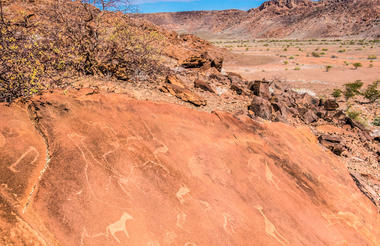
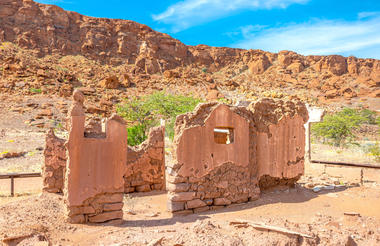
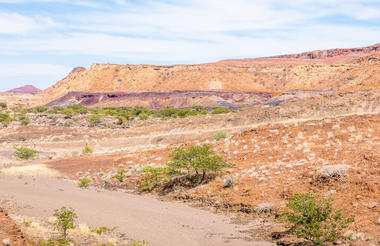
You will spend the morning admiring the Rock paintings and engravings. There are 17 different sites at Twyfelfontein of rock paintings, for a total of 212 stone slabs covered with engravings. There are 13 sites hosting these rock paintings set amongst the numerous rock engravings at Twyfelfontein. To complete your day in Damaraland enjoy a 2hr safari to visit some of Damaraland's most famous attractions including the Burnt Mountain, the Organ Pipes and the highlight of your trip over 2,500 rock engravings at Twyfelfontein, a World Heritage Site.
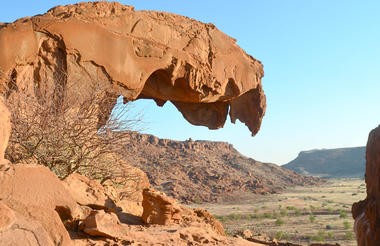
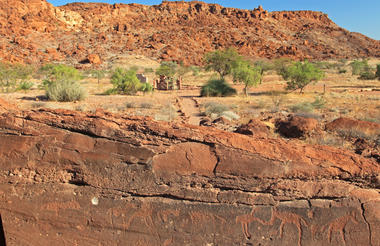
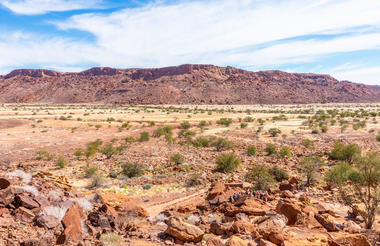
After a hearty breakfast you will then depart to Kaokoland.Kaokoland is one of the last remaining wilderness areas in Southern Africa. It is a world of incredible mountain scenery, a refuge for the rare desert dwelling elephant, black rhino and giraffe and the home of the Himba people. Although it is harsh and offers little respite at midday, the rugged landscape is especially attractive during the early morning and late afternoon when it is transformed with softly glowing pastel shades. Further north, the Otjihipa Mountains rise abruptly above the Namib floor to form the eastern boundary of the Marienfluss, while the west of the valley is defined by the Hartmann Mountains. Kaokoland differs greatly from Damaraland in terms of accessibility and infrastructures. While quite a bit of Damaraland is isolated from the outside world, Kaokoland is empty for the most part of it. With 16,000 or so inhabitants, 5,000 of them Himba, Kaokoland has a population density of only one person to every two square kilometers which is about a quarter of the national average. Upon your arrival you will explore the Kaokoland area and visit the nomadic Himba people.
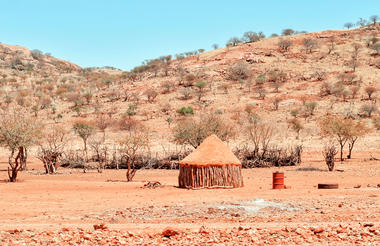
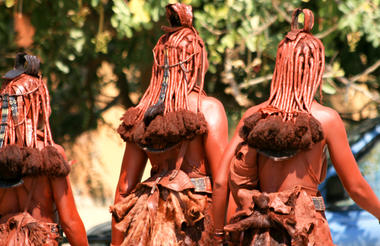
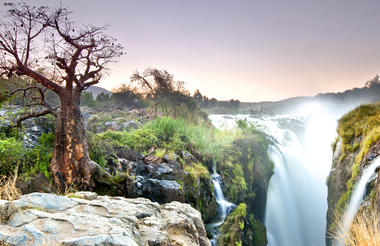
Visit the Epupa Falls that sit on the Kunene River on the border of Angola and Namibia in an area commonly known as Kaokoland. They are created by a series of cascades that drop a total of 60m over a distance of about 1.5km. At one point it reaches a total width of about 500m. This feature is also known as Monte Negro Falls in Angola. The name Epupa is a Herero word for the plumes of spray created by falling water. You will have an enjoyable excursion to finish off your day. You will be driven to a koppie that overlooks Epupa Falls for a drink and a snack as the sun sets.
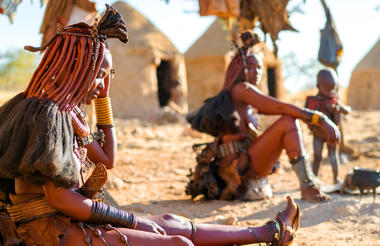
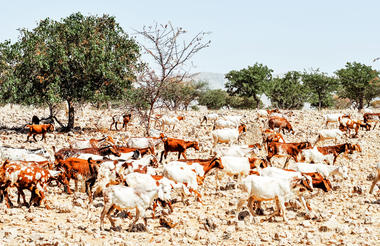
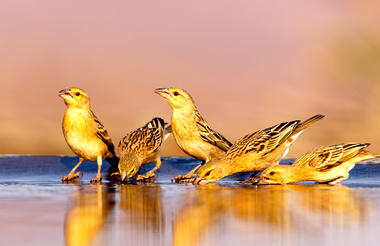
Today you will reach the famous Etosha National Park, one of Africa’s great game parks. Centred around the vast expanse of the Etosha Pan, the park is a sanctuary to the largest population of the western subspecies of the black rhino, white rhino, large herds of elephants, the stiriking black-faced impala, lions and a profusion of other animals and birds. Upon arrival, preferably, go for late afternoon game drives.
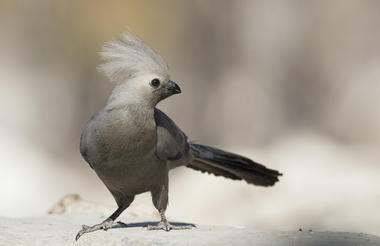
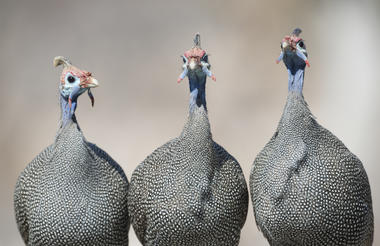
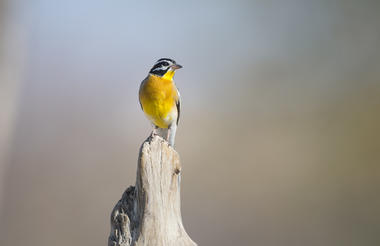
A whole day of game viewing in the Etosha National Park lies ahead of you. Driving along the vast saltpan with stops at various waterholes and game viewing en route.
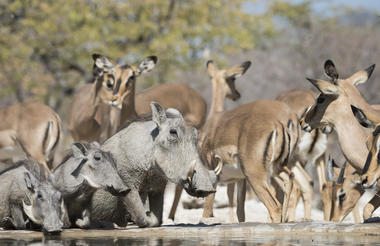
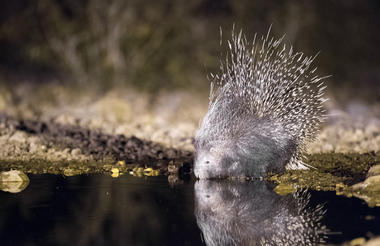

You will have the opportunity to spend some more time to watch the several game species populating the Etosha National Park while you move east to finally exit from the Von Lindequist Gate. You will notice how dramatically the landscape changes during this transfer.



On the last day of your trip you will leave Etosha behind you to head south, towards Otjiwarongo. That's where you will find the headquarter of Africat Foundation, one of the biggest organization supporting the feline conservation, especially of cheetahs and leopards.

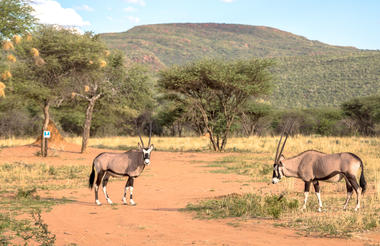
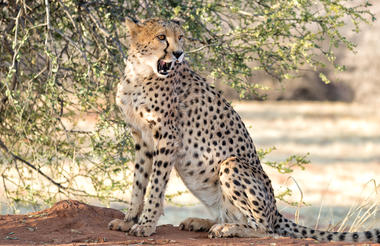
Transfer to the airport on time for your flight.




